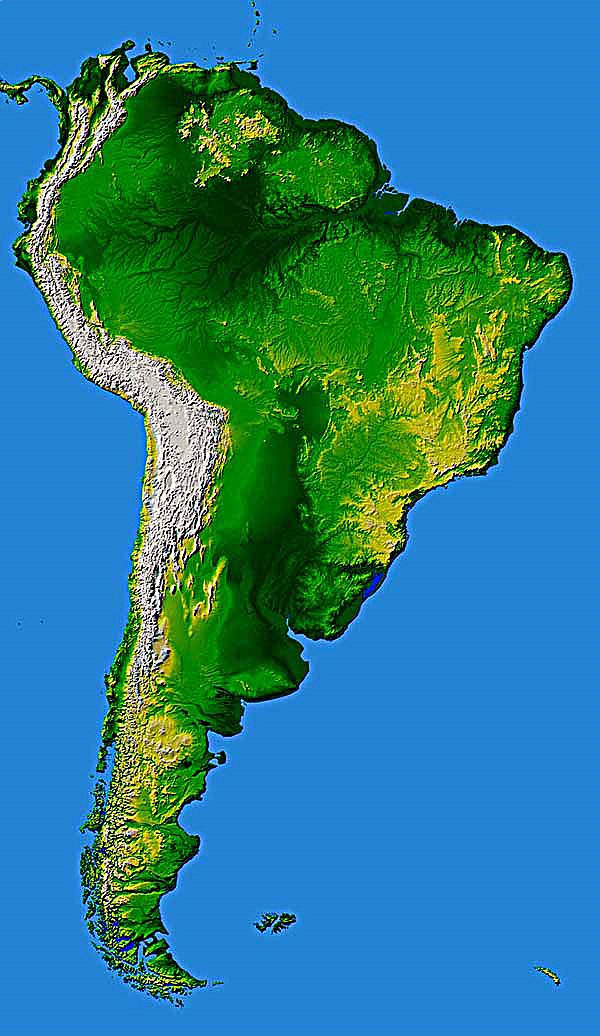|
NASA/JPL/NIMA. “WorldSRTM-noPoles-giant” Online Image. Earth Observatory. 16 May 2005
<http://earthobservatory.nasa.gov/Newsroom/NewImages/Images/PIA03395_lrg.jpg>
South America
This image was created from a larger Public Domain world map produced from data obtained by NASA's
Shuttle Radar Topography Mission (SRTM). The world map was cropped to the South America
and resized to 600 pixels wide using a trial version of Adobe Photoshop. Using Google's free Picasa2 program,
the color and lighting were then enhanced and finally sharpened to obtain the image above. The original
image can be viewed at the NASA link above.
The vast majority of South America was comparatively underdeveloped for most of its history.
At first glance this is surprising since by 2000BC, intensive agriculture had emerged in three
different locations, roughly the same level of development as Europe or China. A few cultures
flourished here, including the important Chavin culture, 900-200BC, but the geography of the
region was extraordinarily difficult. The interior lands east of the Andes Mountains never
developed significantly any more than the
interior jungles of Africa or most of tropical Oceania. To the West, tribes' lifestyles were well
adapted to fishing on the narrow coast between the Andes and
Pacific Ocean, or they were adapted to life in the high mountains. It was historically very difficult for
tribes to extend their influence from one zone to the other, much less expand. The first state in South
America was the Moche in 100BC; by this time there were still only pockets of intensive agriculture lost
in a vast sea of less advanced cultures. So in almost 2000 years, South America produced
only one small state, while Europe was ruled by the Roman Empire and China was ruled by the Han dynasty.
The first
empire in South America at Lake Titicaca was the Tiahuanaco Empire around 400AD. The Huari Empire emerged
just north of Tiahuanaco around 500BC and spread north up the coastal and mountain zones while Tiahuanaco
spread south. Both empires collapsed round 1000AD initiating a period of decentralization until the Inca
Empire emerged in 1200AD. In 1470, the Incas sacked Chan Chan, the capital of the Chimú Empire
destroying the last viable state capable of resisting them with any success. The Incas were at their
peak when the Europeans arrived. And while the Aztecs peaked because Europeans intervened in their
conquests, the Incas had reached the natural extent of their own geographic boundaries. The only way for the
Incas to expand would have been to assimilate less developed populations in the Amazon basin which Europeans
have still not completely reached even today.
In 1532AD, Francisco Pizarro conquered the Inca and the Portuguese had established their first colony in
Brazil. In 1572, all Inca resistance to the Spanish was effectively crushed and the Portuguese had colonized
significant stretches of the Brazilian coast. Despite inroads by Spain’s European rivals in the Caribbean
and North America. Spain and Portugal shared S. America in relative harmony. The Portuguese and Spanish
empires in South America followed similar patterns to the US. Slave owning plantations provided economic
opportunities and dislocated millions of Africans. The European colonists rapidly overwhelmed the native
populations demographically. And like the US, it rebelled. In 1819 Simon Bolivar defeated the Spanish at
the Battle of Boyaca. Within 6 years, Brazil had established its independence from Portugal and the
Spanish controlled states were also free. The independent republics which were established have followed
more or less rocky paths in the years since, but they have continued to exist into the Information Age.
|
